
Virgin Galactic may be funded by a billionaire from Britain, but the company's new president emphasizes the private space effort's "Made in America" stamp.
President and CEO George T. Whitesides can't quite match Virgin founder Richard Branson's bank account. When it comes to credentials in the space community, however, he's hard to beat.
Whitesides, the son of award-winning Harvard chemist George M. Whitesides, is a co-creator of the Yuri's Night space celebration, which will be marking the 50th anniversary of the first human spaceflight and the 30th anniversary of the space shuttle program in April. (His wife, Loretta Hidalgo Whitesides, also was present at the creation of Yuri's Night in 2001.) He served as executive director of the National Space Society from 2004 to 2008. When Barack Obama won the presidency in 2008, Whitesides was on the transition team for NASA and became chief of staff for the agency's new administrator, Charles Bolden.
After riding out a challenging year at the space agency, Whitesides left Washington last May to become Virgin Galactic's chief executive officer. This year, he was given the additional title of president due to the retirement of Virgin Galactic's Will Whitehorn (a Brit, of course).
2011 is shaping up as a big year for Virgin Galactic: In cooperation with aerospace designer Burt Rutan and his colleagues at California-based Scaled Composites, the company is getting its SpaceShipTwo rocket plane ready to take on passengers, perhaps by the end of the calendar year. More than 400 customers have already signed up for a ride to the edge of space, 100 kilometers (62 miles) up, at a cost of $200,000 a seat. It's up to Whitesides to make sure that Branson's money is well-spent, while also making sure that SpaceShipTwo meets the safety standards expected for Virgin's vehicles.
About the only thing Whitesides hasn't yet done in the space business is actually fly into outer space — but he plans to remedy that soon after SpaceShipTwo (also known as the VSS Enterprise) enters service. He and his wife still have their heart set on honeymooning in space, even though they've been married for five years and now have a 6-month-old son (also named George).
Whitesides discussed his vision for Virgin Galactic — and for his son — from his office in Pasadena, Calif., during a telephone interview last week. Here's an edited transcript:
Cosmic Log: So what's the story behind coming to Virgin Galactic?
George T. Whitesides: As you know, I've always been a huge fan of space, and getting more people into space, and furthering this space adventure, which I find to be one of the most inspirational efforts of our time. When I left NASA, this seemed like the most exciting venture I could be a part of. I really do view Galactic as potentially a transformative venture, not just for space development but for humanity's relationship with the cosmos.
Q: How do you think that Virgin Galactic's profile will be changing as you get closer to the first powered flights? Do you feel as if the company's image will be changing? How will the Whitesides era differ from the Whitehorn era?
A: My hope is that we can maintain the public visibility that the company has built up, and the public brand that the company has built over the past year. That brand is centered around, above all, safety — but also the adventure of space, the adventure of Virgin Group. It's about changing the way people think about space — changing it from a world view in which a very small number of people have the opportunity to go to space, to a world in which a much greater number of people can go to space.

We just had a child, and we think a lot about the future that he'll be living in. My hope is that, because of Galactic and other ventures, he'll grow up in a world where anybody who wants to go to space will be able to do it. That's what inspires me right now.
Obviously, over the course of the coming months, I think there will be a lot of attention on the company as we progress through the flight test program. I think that's going to be an exciting time, and that will bring attention not just to Galactic, but to the world of space as a whole, and these trends we're going through in terms of commercial space and entrepreneurial space.
We're all deeply indebted to Will Whitehorn, and just as our names are nearly the same, I hope that there's actually not too much of a difference between the Whitehorn era and the Whitesides era. Will did a fantastic job bringing the company to where he did. I just hope we can maintain that momentum as we go through the next period.
Q: Is there a change in the company's character, moving from a British image to more of an American image? Your ascendancy is one sign of that, but there's also the idea that Virgin Galactic is interested in playing a role in the NASA space program — and interested in being seen as an American company rather than a British company.
A: That's a very good point. Galactic has always been a U.S. company, but because of Richard Branson, there's been an obvious connection to the U.K. To a certain extent, the fact that I'm on board underlines the fact that Galactic is a U.S. company. The technology we're using is based on Scaled Composites' groundbreaking U.S. technology.
Q: Could you talk a little bit about how you see Virgin Galactic getting involved with NASA on suborbital as well as orbital spaceflight?
A: One of the great things about Galactic is that it's still built on a non-government market — that is to say, the individual spacefarer market, the space tourist market, call it what you will. As you know, we're now over 400 people [who have paid deposits for a spaceflight], and over $55 million dollars in deposits. None of that is based on a government program. I think that's really encouraging. It's a sign that there are markets outside the government, and that you can build a human spaceflight business around those markets.
Having said that, I think what NASA's doing is very exciting and absolutely the right direction. Certainly Virgin Galactic is interested in pursuing the CRUSR program, which is this program to fly experiments and technology demonstration payloads on board future suborbital reusable vehicles. We look forward to putting in good proposals for that, that are of value to researchers.
On the orbital part, we did do two partnerships with Orbital Sciences and Sierra Nevada Corp. That's a very interesting area. For us, I think the critical part is, are we building orbital vehicles that are safe and reliable? For the time being, our major focus is going to be on building safe and reusable suborbital vehicles. But the agreements we made with these two companies allow us to get a sense of what the market would be for orbital human spaceflight. We felt that those two proposals had a high degree of reusability, which I think over time will be key to bringing down the cost, not just for government spaceflight customers but also for private customers — who I think would be the ones we would be helping to potentially one day get a ticket.
Q: So for now, Virgin Galactic doesn't see actually building the orbital spaceships as a key priority, but it sounds as if what you're trying to do is take what you've learned from trying to service the suborbital market and see how it applies to the orbital market — and then go from there?
A: That's probably a good way to put it. We feel like we've got a pretty good indication that there's a robust market for suborbital space tourism. Hundreds of people put down real money as deposits. What's exciting for us is that some of the folks who are in that suborbital group have already expressed an interest in potentially doing an orbital experience.
Q: Are there any reflections you'd want to make about having experience on both sides of the desk, as a space activist at the National Space Society, as a government official at NASA and now as a space industry executive?
A: To a certain extent, I hope my experience with those entities informs the work at my new job. I'm very happy about my experience at NSS. NSS and space activist groups are the public spirit of space. They keep the dream alive. NASA has a public trust to manage the public's dollars in a cost-effective way. I came away with great respect for the folks who are there, and also great respect for how hard their jobs are, and how big the goals are. We as Americans expect great things out of NASA, and I think that's the right thing, but it's a challenge when there are limited funds around.
Now, at Galactic, it's obviously a smaller organization than NASA. But I really do think we're doing the most exciting and the potentially most important thing in space right now, which is developing a new market that is price-sensitive and that can over time develop increasingly safer and more capable experiences. I feel very lucky to be able to contribute to that.
Q: I'm sure anytime you talk about what you're doing, people ask you when the rides will become available. What are you able to say about how the time frame is developing? What's the latest?
A: It's funny, Alan, you're the first person to ask me that question ... in the last 10 minutes. As you know, we do not have a public schedule because we want our flight testing to be focused on building a safe vehicle. But as I think others have expressed, and certainly Richard has expressed, our hope is to get to space this coming year. That's obviously dependent on flight test. We'll go into commercial operation as soon as we can, and as soon as we're able to work with the FAA to get a commercial license. So far, things are progressing well. We're very excited about the glide test results — we've just had another fantastic flight. The vehicle is flying very well. So ... so far, so good.
Q: What's it like for you to be working with these icons of aerospace and air entrepreneurship? It must be a kick to be working with Burt Rutan and Richard Branson, and they pay you to do it.
A: Yeah, I really have to pinch myself every so often. Honestly, as a space geek, I view it as a big responsibility. I view this enterprise as an opportunity to move space forward in a way that people have been dreaming about for decades. We want to make the best of that opportunity. A lot of pieces are lined up in the right direction right now.
People have been dreaming about getting a chance to go to space since, well, even before Yuri [Gagarin] and [Alan] Shepard went up 50 years ago. We have a chance to actually make it happen, but we really have to do everything right. So I view this as a great honor, but also as a great responsibility to lead this company in the right direction.
More about private spaceflight:
- Private spaceflight ready to take off in 2011
- Virgin Galactic: Spaceship debut causes chills
- Space Adventures: Orbital tours go back on sale
- XCOR Aerospace: KLM backs Curacao space venture
- Masten: Demo flights planned for Florida
- Russians plan commercial space station
- Ten players in the commercial space race
Connect with the Cosmic Log community by hitting the "like" button on the Cosmic Log Facebook page or following msnbc.com's science editor, Alan Boyle, on Twitter (@b0yle).
